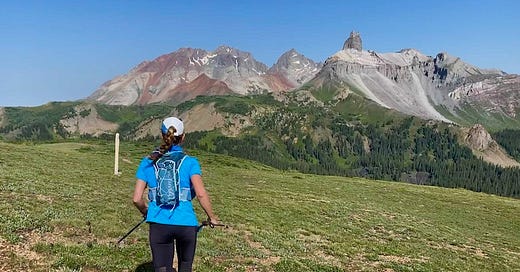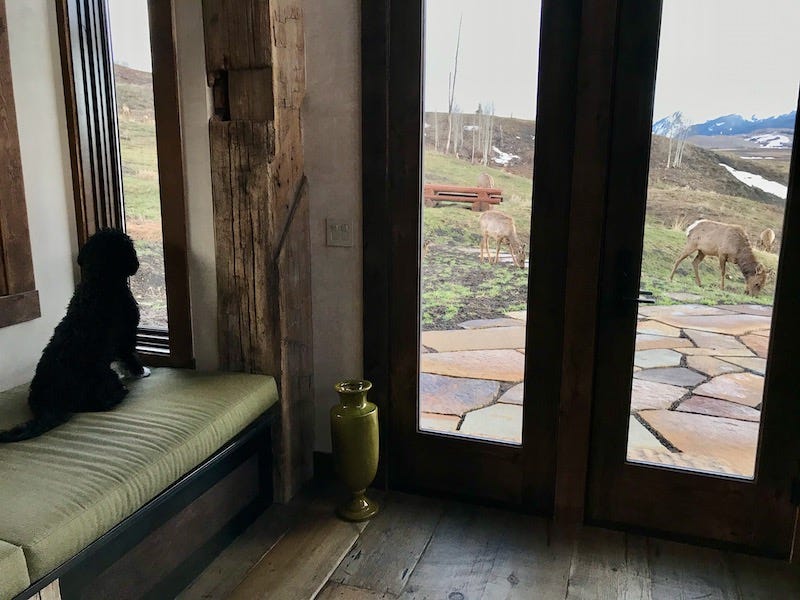This Endangered, Wild, Precious Good Life
The backdrop to running and living in the San Juan Mountains
I had a wave of signups for this four-month-old publication last week. Hello to all you new readers, and thank you. Perhaps you subscribed thinking you’d get a weekly installment of trail-running news relevant to Colorado. Sometimes, you will.
Some weeks, I might write a race report or interview a badass ultrarunner. But this publication is about more than running. I’ve written about shoveling manure, parenting and aging, running-induced reveries, and confronting extreme weather. Let me reintroduce myself and the purpose of this “newsletter” (which is more journal than news).
“Colorado Mountain Running & Living” is about leading a rustic, outdoor-oriented life in the San Juan Mountains and using the practice of mountain running to nurture health, adventure, and a connection with the natural world. I tell stories to share the complexities of living a good life in the mountains, which is full of work, challenges, and (mis)adventures.
As a coach, writer, and longtime runner, I also tell stories about trail running to show how it can fit into and enhance one’s life in a way that might be described as “old school” and individualistic in this era of ever more attention-seeking runners coming up in the burgeoning sport, many driven to make a name and a living for themselves through sponsorship, competition, and media platforms. I respect and understand their drive and their need to make money; I just hope to show, as an alternative, that you don’t have to aspire to go pro to have a meaningful, “long-running” involvement with the sport.
I am an older empty-nester woman, turning 53 this year, whose two kids are young adults living away from home. I live an undeniably good and privileged life on 35 scenic acres at 9000 feet, cradled by mountains, in a dream home built from scratch that my husband of 32 years and I worked hard through adulthood to afford.
I ran my first ultra 15 years ago, after a decade-plus of marathoning, and ever since then, ultrarunning has shaped who I am and what I do. My daily practice of running supports this good life like the trusses on our timber-frame home. Running in the high-altitude mountains (with hiking blended in) gives me strong bones and a robust heart, a calmer and more confident mindset, and a structure to daily life that bolsters working independently from home, which at times can feel unstructured and isolating.
Like my lifestyle, which used to be fast paced and urban, my relationship with running has evolved over three decades. My earlier care about competition, cumulative mileage, and personal-best times has shifted toward running primarily for physical and mental health, for exploring trails, for connecting with other runners, and for feeling youthful and gutsy.
I’ll keep training for 100-milers the way my grandfather kept hiking mountains and running rivers in his senior years, because of the way the challenges and journeys that come from human-powered locomotion make us feel and think. And because we can until we can’t.
My husband Morgan and I bought land here, six miles outside of Telluride, in 2016 because family members live here, I spent part of my childhood here, and our roots run deep in this region. This place became the happy spot we yearned to visit during earlier decades in California. Now that our two children are mostly independent, we devote attention to many animals: two horses, two dogs, a cat, and a lot of chickens, and we coexist with elk, hawks, magpies, coyotes, rabbits, and smaller critters.
It sounds idyllic, and most days it is, but my eyes are open to the tension, transitions, and threats to this mountain life, related to climate (especially drought and wildfire risk), population growth, and economic inequality. I also realize my running likely has a shelf life with an expiration date approaching. I observe and feel my body gradually changing, from hormonal shifts, wear and tear, sun exposure, and the thin air. My left patella protests when I kneel down, my lower back twinges when I hoist a hay bale, and I recently started needing glasses to drive.
It’s easy to think the best years are behind us. But I don’t want to be like my dad, as much as I admired and loved him. He built the cabin across the road in the 1970s and was active in the Telluride community until declining health made it too difficult for him to live and breathe here. He often groused about how the area was changing—about “the beautiful people” moving here and building mansions around the ski resort (while he somewhat hypocritically enjoyed the new golf course there)—and he’d thunder in his unrestrained way, “Growing old sucks!” He died of lung failure at 77 after a life of smoking and heavy drinking.
I’m trying to resist that depressing outlook and outcome by living the most optimistic and active life I can, with gratitude and generosity. The threats to our future enhance my appreciation every day of life in these mountains—every day I get to walk up our driveway gazing at Wilson Peak or lead the horses to pasture to let them graze, or spot the coyote watching me from her hillside perch in the aspens (I think she’s a she because I’ve watched her squat instead of lift her leg to pee), or when I look up from my laptop to observe the sunset behind Little Cone.
Therefore, I also write stories to chronicle an exquisite, evolving, endangered mountain life—and all the life that this swath of land nurtures, including that of a runner, horsewoman, homemaker—because in a generation, it and she may have desiccated and declined beyond recognition.
I am a podcast junkie. I listen to a lot of episodes while running and while driving back and forth to Montrose, an hour and 20 minutes away, where I visit my mom in her assisted-living memory care unit and visit the horses, who temporarily reside in a pasture there during winter (because our land gets too snowy to exercise them at home). I also buy groceries and gas there because it’s much more affordable than in pricey Telluride.
I have three to recommend that I listened to recently, and all tie into this mountain-life discussion.
First is an Outside podcast, “Who Killed the Ski Bum?” that explores the transformations of mountain towns and the threats to the idealized notion of the ski bum, who with hard work can live affordably in the mountains and devote all free time to the sport. Not only is the future of snow at risk, but also, the character that makes these towns appealing. Midway through, a lifelong resident of Telluride sums up the changes here: “Aesthetically, the town has lost a lot of its vibe, because everything is being fancy-fied, and the funk is getting renovated out of it. Somebody arriving here and trying to set down roots, and maybe establish a business and purchase a single-family home—that’s quite unattainable unless you have a big pile of cash.” She expresses the need for anyone who cares about the ski-bum lifestyle of yore to get involved with caring for and preserving the community.
I also have appreciated getting to know a woman, Kelton Wright, who’s devoting herself to fixing up a log cabin in a remote high-altitude mountain town. She writes about her life and the setting on another Substack newsletter, Shangrilogs, and out of respect for her neighbors, she doesn’t reveal what or where this town is, to avoid making it more of a destination. Kelton was interviewed on this podcast and articulated what it takes to be a good citizen in a mountain town, and what she does to lead a more sustainable lifestyle. It’s worth a listen.
Finally, I recommend an interview with Corrine Malcolm, a coach and commentator in the sport as well as an elite-level ultrarunner. Her interview on the Singletrack podcast offers a great deal of wisdom and predictions about the state of the sport and some notable personalities in it.
Corrine had a line toward the end that hit me. She was asked whether she had read any good books lately, and she talked about Pam Houston’s memoir Deep Creek (a book I’ve also read and liked a lot), about Houston’s ranch near Creede, which became a sanctuary to heal from an abusive life. Houston meditates on what it means to care for the land and animals, and what we can do to help a threatened, damaged world. Corrine said in her interview, “It just makes me want to buy a ranch in the middle of nowhere and live a very simple life of shoveling a path to the horse pasture and that kind of stuff.”
Hearing that was a powerful reminder to me that I should never take for granted—and always make the most of and steward the best I can—this life on uncrowded land with animals.
After listening to those podcasts, I thought more deeply about how to give back to the community and take care of the place where we live—about what I plan to do with this one wild and precious life.
I’m making a small difference locally—at least, I hope I am—by volunteering to lead a local service organization (Telluride Rotary Club). As club president this year, I bring people together for networking and raise money for projects and scholarships, and I line up guest speakers to talk about issues that matter to the region. But as soon as I rotate out of that leadership position later this year, I’ll seriously consider taking on a part-time job that serves people more directly.
Our local newspaper is filled with dozens of ads for service-oriented jobs, but no listings for housing. The housing shortage continues to create staffing shortages and long commutes for workers who can’t afford to live any closer than Montrose or Naturita. Maybe I could substitute teach for the school district, since there’s a chronic dire need for subs, or maybe I could fill in at my favorite cafe that always needs counter help. Who knows? I just feel a gnawing responsibility to help out more in town, instead of spending the majority of my time working independently and running in the mountains.
Do you have ideas on how to give back to the place you love? I’m aware that even asking that question is a sign of privilege, as those who are working to make ends meet and devoting themselves to raising kids are likely doing all they can, and not everyone gets to live in a place they love. But if you have the gift of a mountain life with time for recreation, what might you do to take care of the natural world and community around you? I welcome your comments below.








